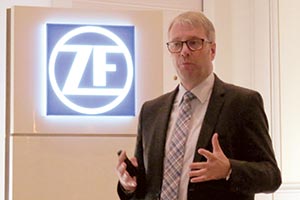Managing Editor, Features and Multimedia
ZF Unveils Evasive Maneuvering System, Automated Driving With Active Steering

This story appears in the July 11 print edition of Transport Topics.
ALDENHOVEN, Germany — ZF Friedrichshafen unveiled its latest advances in automated driving technology for trucks, including emergency steering to avoid imminent collisions and a highway driver-assist system that automatically keeps the vehicle in its lane while maintaining safe following distances.
These functionalities, demonstrated by a pair of ZF’s Innovation concept trucks on a test track here, are among the next steps in the component supplier’s broader push to bring increasing levels of automation to commercial vehicles, company executives said here June 29 at its 2016 global press event.
The new Innovation trucks also represent the combined efforts and capabilities of ZF and TRW Automotive Holdings Corp., which ZF acquired just over a year ago for about $12.4 billion.
At a press briefing the previous day in nearby Aachen, Germany, CEO Stefan Sommer said ZF’s strategy in the next decade will focus primarily on three industry “megatrends” — safety, efficiency and automated driving.
To support the movement toward automation, ZF is developing technologies that “see,” “think” and “act,” he said.
Onboard sensors such as radar, cameras and lidar can enable the vehicle to “see” its surroundings. Next, algorithms draw conclusions from that information. Finally, the right components and systems enable the vehicle to automatically accelerate, brake and steer based upon those calculations.
Sommer said the next wave of automation, including evasive emergency steering and automatic lane keeping, could become available on the commercial truck market as early as 2019 or 2020, based on typical development cycles with original equipment manufacturers.
The press event featured the debut of the Evasive Maneuver Assist system, which ZF developed jointly with Wabco Holdings Inc.
That crash avoidance technology is designed for situations where the truck cannot prevent a rear-end collision through braking alone. In those cases, the system helps the driver steer around a vehicle or other obstruction in the road and bring the truck to a safe stop.
In a statement, Wabco CEO Jacques Esculier said the new functionality “marks an important step toward realizing the transportation industry’s vision of autonomous driving.”
During test-track demonstrations, Evasive Maneuver Assist enabled a driver traveling at highway speeds to quickly swerve around an obstacle on a wet road surface moments before impact.
However, the current prototype for heavy-duty trucks still relies on the human driver to ensure that the adjacent lane is clear of traffic. The driver manually turns the wheel right or left to trigger the system, which then takes control to automatically maneuver around the obstruction ahead in a safe manner.
In contrast, a version of the technology for passenger cars does not require driver interaction and includes sensors to monitor the vehicle’s sides.
The car system is further along because it has been in development longer, but the goal is to offer a similar level of automation in trucks, said Gerhard Gumpoltsberger, head of innovation management and testing at ZF. That will require additional development work, testing and more sensors on the truck, he added.
The evasive maneuvering function combines active braking provided by Wabco’s OnGuard- Active radar-based collision mitigation technology and active steering from ZF’s electrohydraulic ReAX power steering system.
In a separate demonstration, ZF showcased its Highway Driving Assist function on a second Innovation truck.
That system, which merges active steering with adaptive cruise control, enabled the driver to take his hands off the wheel and watch as the truck kept itself centered in its lane on a highway-like section of the test facility. The truck automatically maintained a safe following distance from a car, and stopped itself when the car ahead came to a halt.
That truck also showcased ZF’s SafeRange function, which enables a driver to back the truck into a loading dock from outside the vehicle by controlling it with a tablet. The company first unveiled that concept in 2014, but the latest version of the technology incorporates the use of stationary cameras installed on the loading dock to help guide the vehicle’s movement. The cameras track a target on the rear of the trailer to prevent maneuvering-related accidents.
Peter Lake, a ZF board member who was an executive at TRW prior to the merger, said the automotive industry is entering an “unprecedented period of change.”
“Our future is electrified and connected,” he said. “You’re seeing what have historically been mechanical systems evolve very rapidly into electromechanical and electronic. You’re seeing electrification of the driveline, and of the principal actuators, digitization and connectivity of the vehicle.”
He also said the TRW acquisition expanded ZF’s technology portfolio and “accelerated the company’s journey in the direction you are seeing.”
ZF previously held a 50% stake in steering supplier ZF Lenksysteme, a joint venture with the Bosch Group, but sold its stake in that business to Bosch in January 2015.
Following the May 2015 purchase of TRW, ZF now has 100% control of its own steering business and is “more able to direct its future,” Lake said.
“This arena of steering is absolutely central to automated driving and dynamics,” he added.

